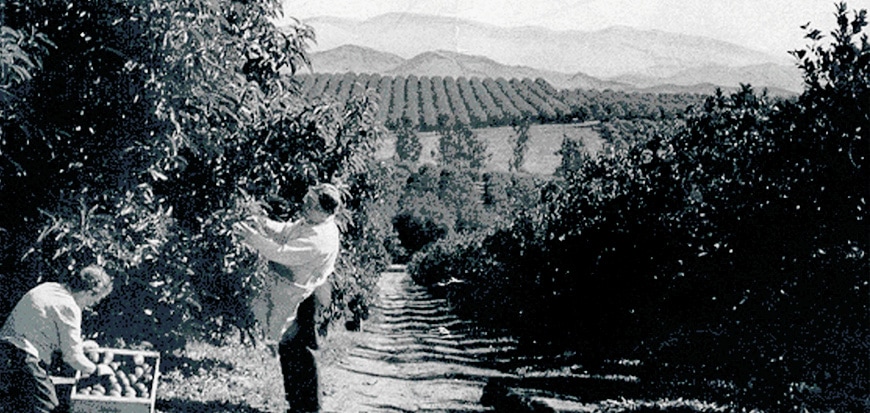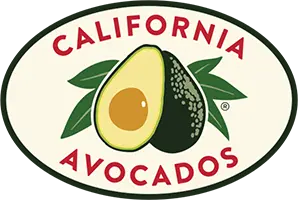
As with all fruits and vegetables, wash avocados before cutting. Check out our tips for how to choose and use California Avocados
The California Avocado is a native American plant with a long, distinguished history. Today, the most popular variety is the Hass. The mother tree of all Hass Avocados was born in a backyard in La Habra Heights, California.
Avocado History
The avocado (Persea americana) originated in south-central Mexico, sometime between 7,000 and 5,000 B.C. But it was several millennia before this wild variety was cultivated. Archaeologists in Peru have found domesticated avocado seeds buried with Incan mummies dating back to 750 B.C. and there is evidence that avocados were cultivated in Mexico as early as 500 B.C.
From Aguacate to Avocado
Spanish conquistadores loved the fruit but couldn’t pronounce it and changed the Aztec word to a more manageable aguacate, which eventually became avocado in English. The first English-language mention of avocado was by Sir Henry Sloane in 1696.
California’s Cash Crop
Fast forward to 1871, when Judge R.B. Ord of Santa Barbara successfully introduced avocados to the U.S. with trees from Mexico. By the early 1900s, growers were seeing the avocado’s commercial potential and ever since growers, enthusiasts and researchers have been hunting for improved varieties. A search through the industry’s foremost annals, in particular the California Avocado Society Yearbook, reveals that many new selections of avocado were made in the industry’s infancy and over subsequent years but few had commercial significance. By the 1950s around 25 different varieties of avocados were being commercially packed and shipped in California, with ‘Fuerte’ accounting for more than two-thirds of the production. Even though ‘Hass’ was discovered in the late 1920s and patented by Rudolph Hass in 1935, it was not until large-scale industry expansion occurred in the late 1970s that ‘Hass’ replaced ‘Fuerte’ as the leading California variety.
Today, California is the leading producer of domestic avocados and home to about 90 percent of the nation’s crop. Most California Avocados are harvested on approximately 50,000 acres from Monterey through San Diego by about 3,000 growers. Ventura and San Diego top the list of avocado producing counties in California.
California Avocados are grown year-round. A single California Avocado tree can produce up to 200 pounds of fresh fruit each year, approximately 500 pieces, although most average around 60 pounds or 150 pieces of fruit.
THE HASS AVOCADO – A CALIFORNIA NATIVE
1926-2002
In 2002, the tree to which every Hass Avocado in the world can trace its lineage finally succumbed to root rot at the ripe old age of 76. Her offspring account for 95 percent of the avocados grown in California, and the fruit of her labor resulted in one of the state’s most important industries. Yet, despite speculation to the contrary, nobody knows what variety of seed produced the original Hass Mother Tree.
The tree began life as lucky-find; a simple seed planted by A.R. Rideout of Whittier. Rideout, an innovator and pioneer in avocados, was always searching for new varieties and tended to plant whatever seeds he could find, often along streets or in neighbors’ yards.
In the late 1920s, Mr. Rudolph Hass, a postman, purchased a seed from Rideout, and planted it in his new orchard. He planned to graft another variety on it, but when repeated grafts didn’t take he planned to cut the tree down. Fortunately for avocado lovers everywhere, Hass’s children talked him out of it. They preferred the taste of the tree’s fruit to that of the Fuerte, the predominant variety and industry standard in those days.
Since the quality was high and the tree gave a good yield, Hass named the variety after himself and took out a patent in 1935. That same year, he signed an agreement with Harold Brokaw, a Whittier nurseryman, to grow and promote the Hass Avocados. They would split the gross income: 25 percent for Hass and 75 percent for Brokaw.
Brokaw began to propagate the rough, black Hass exclusively and promote it in favor of the standard varieties of the day. It made sense. The Hass was a far better bearer than the Fuerte and it matured at a different time of year. Because of the seasonal advantage, Brokaw was successful to the point of yearly sellouts of his nursery crops.
The patent expired in 1952, the same year Rudolph Hass died. But by then, the bumpy black avocado that bore his name was rapidly gaining in popularity on the smooth green Fuerte. Consumers preferred its richer, nuttier taste, while grocers favored it for its durability and longer shelf life. Today, the Hass accounts for about 80 percent of all avocados eaten worldwide and generates more than $1 billion a year in revenues in the United States alone.
The tree that launched an avocado revolution lived out her days in suburban La Habra Heights. Harold Brokaw’s nephew Hank nursed her through more than a decade, trying to save her from root fungus. Hank lost the fight in 2002, and the tree’s wood is currently in storage in a Ventura nursery awaiting the decision on a fitting commemoration of the original Hass Mother Tree.


Comments